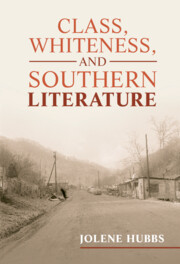Book contents
- Class, Whiteness, and Southern Literature
- Cambridge Studies in American Literature and Culture
- Class, Whiteness, and Southern Literature
- Copyright page
- Contents
- Figures
- Acknowledgments
- Introduction
- Chapter 1 Riffraff and Half-Strainers
- Chapter 2 Slow, Sweating, Stinking Bumpkins
- Chapter 3 Civil Rights and Uncivil Whites
- Chapter 4 Hungry Women and Horny Men
- Coda
- Notes
- Bibliography
- Index
- Recent books in this series (continued from page ii)
Chapter 4 - Hungry Women and Horny Men
Dorothy Allison, Barbara Robinette Moss, and Grit Lit
Published online by Cambridge University Press: 01 December 2022
- Class, Whiteness, and Southern Literature
- Cambridge Studies in American Literature and Culture
- Class, Whiteness, and Southern Literature
- Copyright page
- Contents
- Figures
- Acknowledgments
- Introduction
- Chapter 1 Riffraff and Half-Strainers
- Chapter 2 Slow, Sweating, Stinking Bumpkins
- Chapter 3 Civil Rights and Uncivil Whites
- Chapter 4 Hungry Women and Horny Men
- Coda
- Notes
- Bibliography
- Index
- Recent books in this series (continued from page ii)
Summary
While the first three chapters focus on formal innovations developed by middle-class writers who strove to contest other middle-class writers’ classist portrayals of poor white southerners, the fourth chapter considers techniques pioneered by authors who grew up poor, concentrating on literary devices designed to rebut deep-rooted narratives about poor white southerners’ unhealthy appetites. Reading Dorothy Allison’s novel Bastard Out of Carolina and Barbara Robinette Moss’s memoir Change Me into Zeus’s Daughter in light of the rise of southern foodways—in 1999, the year Moss published her memoir, the Southern Foodways Alliance was founded and USA Today named Paula Deen’s restaurant The Lady and Sons the International Meal of the Year—I explore how these authors wrote hunger into the bodies of their texts. I also examine how Allison’s and Moss’s works push back against male grit lit writers’ depictions of delectable poor white women by presenting decidedly inedible female characters, as Allison’s heroine’s nickname—Bone—suggests.
- Type
- Chapter
- Information
- Class, Whiteness, and Southern Literature , pp. 94 - 122Publisher: Cambridge University PressPrint publication year: 2022

